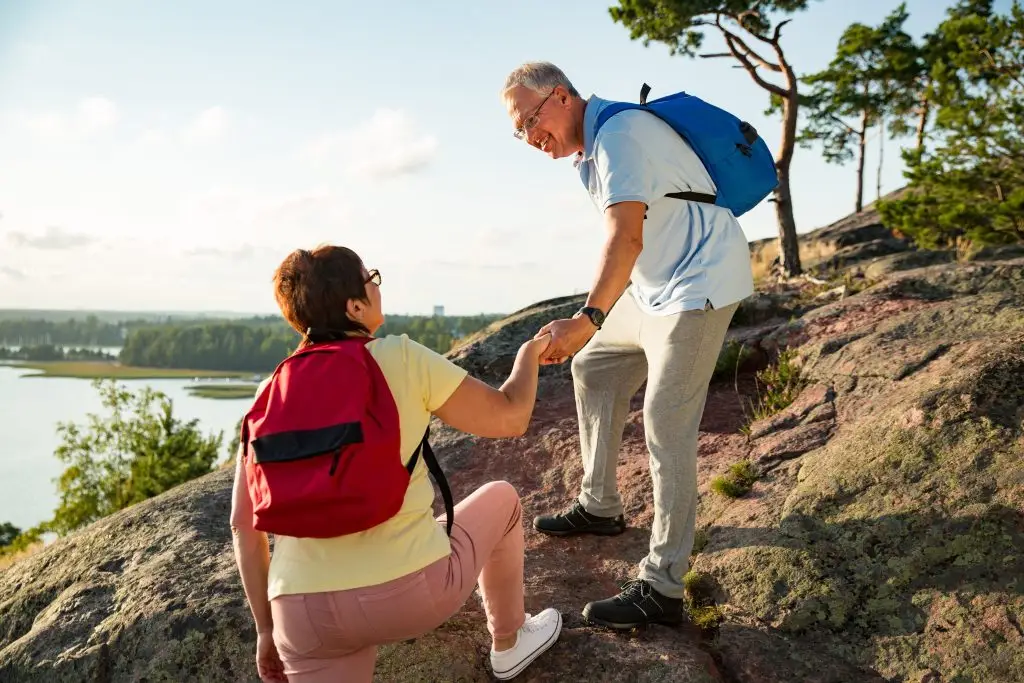Falls affect one in four Americans aged 65 and older each year, making it a leading cause of serious injury for aging folks everywhere. But these statistics don’t have to be the normal for you or your loved ones, and there are even simple steps you can take in the comfort of your own home to reduce your risk of falling.
Whether you’re noticing subtle changes in your stability or proactively planning for healthy aging, improving your balance can make the difference between maintaining independence and enjoying things like traveling and hiking.
Balance exercises for older adults
The key to staying active in retirement and beyond lies in functional exercise that targets areas most vulnerable to decline. As the saying goes, “Move it or lose it!”
The best balance exercises for seniors should focus on real-world movements that translate to daily activities. Balance training can incorporate holding specific postures, dynamic movements, and coordination challenges that mirror the unpredictable nature of everyday situations.
At-home balance training
While professional guidance provides the most comprehensive benefits, you can begin improving your balance immediately with simple at-home exercises. These exercises for balance require no special equipment and can be easily incorporated into your daily routine.
- Single-leg stands: Start by standing behind a sturdy chair, lifting one foot slightly off the ground, and holding for 10-30 seconds. Increase the difficulty by closing your eyes, extending your arms, or standing on different surfaces like a folded towel or foam pad.
- Heel-to-toe walking: Walk in a straight line, placing the heel of one foot directly in front of the toes of the other foot. Take 15-20 steps, focusing on smooth, controlled movements. Use a wall for support initially, then try without assistance.
- Chair-based exercises: Seated leg extensions, ankle circles, and upper body movements while maintaining proper posture all contribute to better balance by strengthening core muscles and improving body awareness.
- Wall push-ups: Stand arm’s length from a wall, place your palms flat against it, and perform push-ups while maintaining straight body alignment. This exercise strengthens the core muscles essential for balance as well as the shoulders and upper back muscles.
- Standing marches: Lift your knees alternately while standing in place, as if marching. This dynamic movement challenges your balance while strengthening hip flexors and improving coordination between your legs.
With any of these exercises, start with shorter durations and fewer repetitions, gradually increasing as your ability improves. Consistency matters more than intensity—practicing these exercises every day for 10-15 minutes yields better results than intense sessions done less frequently.
What to expect from physical therapy balance training
If these at-home exercises aren’t right for you or your loved one, the next step would be getting a personalized balance training plan guided by a physical therapist.
Professional physical therapy elevates balance training beyond basic exercises, offering targeted interventions for specific issues or goals. A physical therapist evaluates your unique balance challenges, identifies underlying issues, and creates a comprehensive treatment plan addressing your unique needs.
Treatment typically includes flexibility and dexterity training alongside general leg strength exercises. Tight muscles and limited range of motion become common in older age, so therapists address these issues through targeted stretching and mobility work. Ankle flexibility, hip mobility, and spinal alignment all play crucial roles in maintaining stability.
Therapy sessions typically progress from static exercises to dynamic challenges, eventually incorporating activities that mirror your daily routines. You might practice stepping over obstacles, carrying objects while walking, or responding to unexpected balance shifts. This functional approach ensures that your improved balance directly benefits your quality of life.
The benefits of balance training go beyond simply limiting the risk of falls. Patients who commit to the treatment plan report feeling increased confidence with their improved mobility in nearly every area of their lives. Building physical strength in this way can often improve mood, self-confidence, and other health outcomes as a result of becoming more active.
Personalized balance improvement through age-appropriate training
Learn how you can live and feel better with better balance and mobility through physical therapy. Our team at Continuum Wellness in Apache Junction frequently sees how balance training and physical therapy improves the lives of older folks in our community, no matter what their health concerns might be or current mobility level.
Find out more about balance training exercises that are right for you or your loved one by calling our clinic or by requesting an appointment online today.
